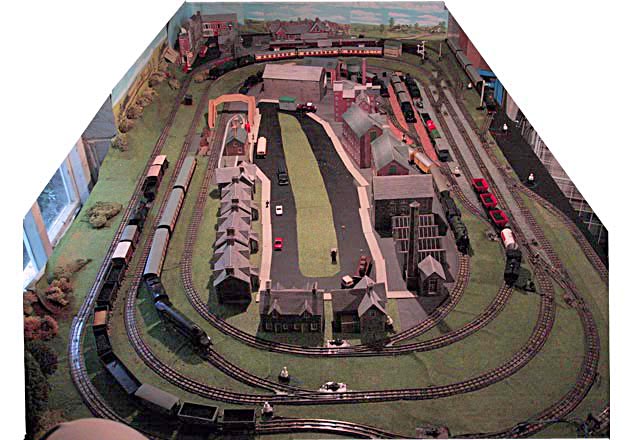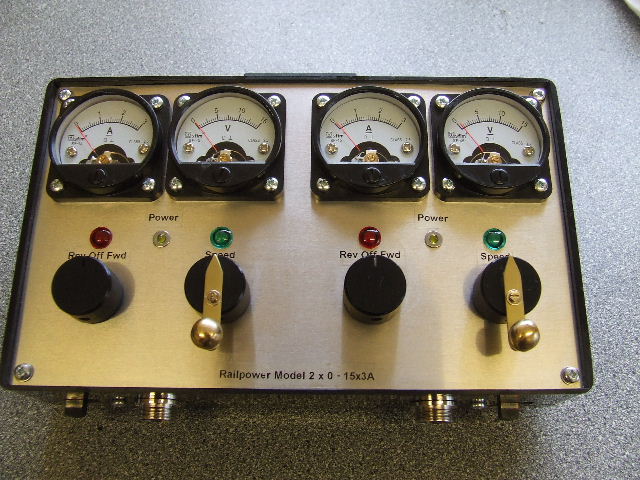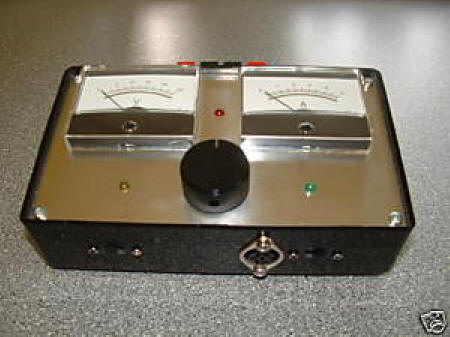Richard asked me what controllers do I use and what would I recommend with slow running in mind.
Lets start with the history.

Three interlinked ovals all operated by HD A3 controllers. The inner track remains the same but the two outer tracks have been lengthened 3 times so they are long. Intermediate controller to track extensions were added as the track was lengthened to reduce voltage drop. Each of the long tracks has 3 additional connections to the controller.
The inner track is still operated by the original A3 controller – that is over 21 years.
The A3’s on the outer tracks were replaced by an H & D Duette following a failure. This lasted for some years and failed but was replaced like for like but the replacement failed pretty quickly.
(Note the controllers in the background are Marklin 14V AC as I have a couple of old Marklin engines. At the moment only one is in operation)
The Duette was replaced by 2 H & D Clippers which are rated at 1 1/4 amps compared to 1 Amp for the Duette. After 2 failures and replacements I decided to go for something modern.
I chose a controller from Superneomagnets

As you can see this has built in meters for voltage to engine and the amps being consumed. The latter is very good at diagnosing a potential problem. All my HD engines run from 0.2 amps to 0.6 depending on the engine – this does not increase with voltage but can go up a little with a heavy load. Any engine pulling above 0.7 amps should be checked over.
There is always an exception as I have a Bo-Bo which has always pulled 0.9 amps when running and it has been doing so for about 10 years.
This controller initially had some teething problems which were all fixed at no cost but the controller had to be sent away. So out came the remaining working clipper and I added a Trax handheld feedback controller based on Ron Dodds You Tube video. This worked well but did not have the power of the H & D (i.e – the trains ran slower) and at low speed some of them made a strange jangling noise possibly caused by the fact that these are feedback controllers. However I did buy a second one which I still intend to use to replace the A3 controller. Its just taken 5 years and still haven’t got round to changing it – if it works leave it alone.
The remaining Clipper is used in the maintenance and test area.
I have no experience with any other controllers.
That’s what I have but I decided to try and be a bit scientific before making any recommendations.
The HD A3
| Controller | Position | Voltage direct from controller | Track Voltage No Train | Track Voltage train running |
| HD A3 | first position | 9.3 | ||
| Mid position | 13 | |||
| High position | 15.9 |
This is sort of a controller with a max output of nearly 16V – where did that come from? I thought that this was clearly a broken one like my other 2 so not really worthy of comparison, I asked Richard to carry out a test on his A3
| Richard’s | first position | 14.3 | ||
| A | Mid position | 14.3 | ||
| HD A3 | High position | 14.3 |
So I retested by A3 with no train running
| HD A3 | first position | 15.9 | ||
| Mid position | 15.9 | |||
| High position | 15.9 |
So with no train running the controller gives maximum voltage to the track at any position on the control handle. What is the physics behind that? And the answer is a rheostat. The A3 is a rheostat based controller which varies the current applied to the track/engine not the voltage. The high voltage output of these controllers could be an age/wear factor but might not be, it could be that they were designed that way, They are 70 years old so perhaps we will never know.
H & M Clipper
| H & M Clipper | Position 1 | 1.1 | ||
| 2 | 2,6 | |||
| 3 | 7,7 | |||
| 4 | 12.6 | |||
| 5 | 14,2 |
A reasonable degree of control but an interesting 14 volts at max output. This is my test unit so not connected to any track.
H & M Duette
| H & M | Position1 | 0.2 | ||
| Duette | 2 | 2.1 | ||
| 3 | 6.6 | |||
| 4 | 11.8 | |||
| 5 | 13.7 |
A good control of track voltage but with nearly 14 volts at max.
Trax handheld feedback controller
| Trax Up Line | Position 2 | 1.2 | 1.8 | |
| 4 | 8.2 | 6,4 | ||
| 6 | 10.8 | 8.1 | ||
| 8 | 11.5 | 8.8 | ||
| 10 | 11.8 | 9.6 | ||
| Trax Down Line | Position 2 | 1.5 | 2.3 | |
| 4 | 6.2 | 6.6 | ||
| 6 | 11 | 9.4 | ||
| 8 | 11.7 | 10.2 | ||
| 10 | 11.9 | 10.5 |
A slow movement on position 4 with some of my engines but not something I worry too much about. It is definitely a 12V controller with not a lot of change between positions 6 and 10. No Mallard record on these controllers and a “jingly” noise below 6 on some of my engines – which would not be as well maintained as Ron’s.
Superneomagnets controller
| Superneomagnets controller | ||
| Down Line | ||
| Volts shown on meter | Actual track voltage No train | Actual track voltage train running |
| 2.5 | 2.2 | 1.7 |
| 5.0 | 4.8 | 4.4 |
| 10.0 | 9.5 | 9.4 |
| 12.5 | 11.8 | 11.8 |
| 14.0 | 13.6 | 13.0 |
| Superneomagnets controller | ||
| Up Line | ||
| Volts shown on meter | Actual track voltage No train | Actual track voltage train running |
| 2.5 | 2.3 | 2.3 |
| 5.0 | 4.9 | 4.1 |
| 10.0 | 9.5 | 9.2 |
| 12.5 | 11.9 | 11.8 |
| 14.0 | 14.0 | 13.2 |
Good slow speed running with an added boost at the top end for a bit of express passenger running. I bought mine back in 2014 along with the hand helds, an option, which I found very worthwhile, Allister Hughes is still making them but they now look more up to date

If I had 2 working clipper controllers I wouldn’t change them. If one broke I wouldn’t replace it as you would start the same cycle I got into.
Trax is very cost effective, 2 hand helds and a transformer for under a £100. The transformer gives 2 outputs at 15 volts AC at 1.5 amps. A single handheld with single transformer is under £50. And you might not need the transformer as both the A4 and the clipper provides a 15V AC outlet at 1 amp and 1,25 amps respectively which could be used to power the Trax handheld. If you are only running one HD train then either will do but if you want to double head then you will need at least the 1.25 amps. The Superneo controller allows 2 amps so plenty of headroom. Most of my 0-6-2T’s, 2-6-4T’s and 0-6-0T’s run at around 0.4 to 0.5 amps as indicated on the controller.
I have never tried Gaugemaster controllers.
Both the Trax and Superneo controllers allow for very slow running but slow starting from stationary is much more dependant on the engine than it is the controller. Some engines will start slowly and speed up with the controller others need a “voltage spurt” to get them going but probably all down to maintenance and age
For my motley and large collection of locos the Trax is a bit weak ((pulling power and speed) but adequate but I would not change my Superneo controller – powerful and it shows the amps the engine is using so a great safety tool for not burning out armatures.

Wow, Tony, that’s a very helpful detailed analysis. I have a rewired A3 which operates an inner loop and a test track quite well. My H and M Duette I use for my outer and inner circuits and also is functioning well. They both have that extra bit of power needed for Dublo locos.
No experience of “feedback” controllers as I have not been to any exhibitions, but I note that you also say that they have less power, great for slow running control, but then HD locos can be noisier.
I like what you say, if it works fine, keep it! Hopefully my old ones will still function ok for my lifetime!
I did try Gaugemaster twin D for 00 gauge controller.
Brought brand new.
Worked but my EMU was very sluggish and control a bit on off.
Have exhausted all the how to videos I in desperation refitted my 60 year old A3. Guess what the EMU took off like a greyhound.
Control is back as well. Nothing against Gaugemaster and reused on other modern layout but I dont think it has the power needed for Dublo motors.